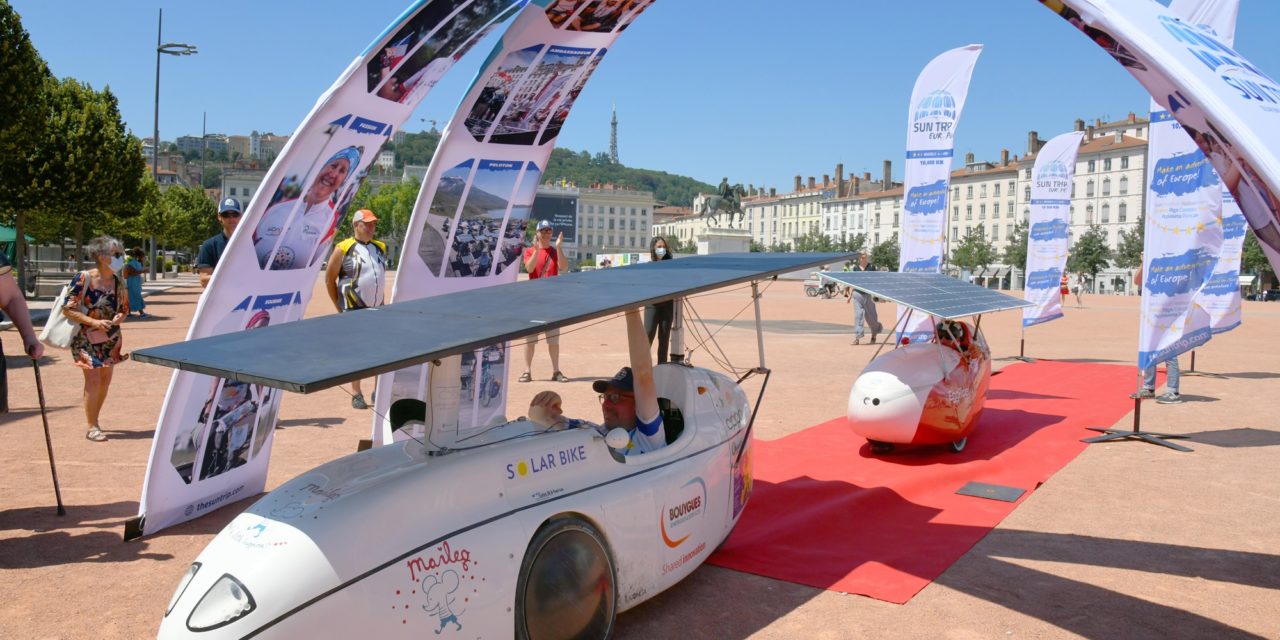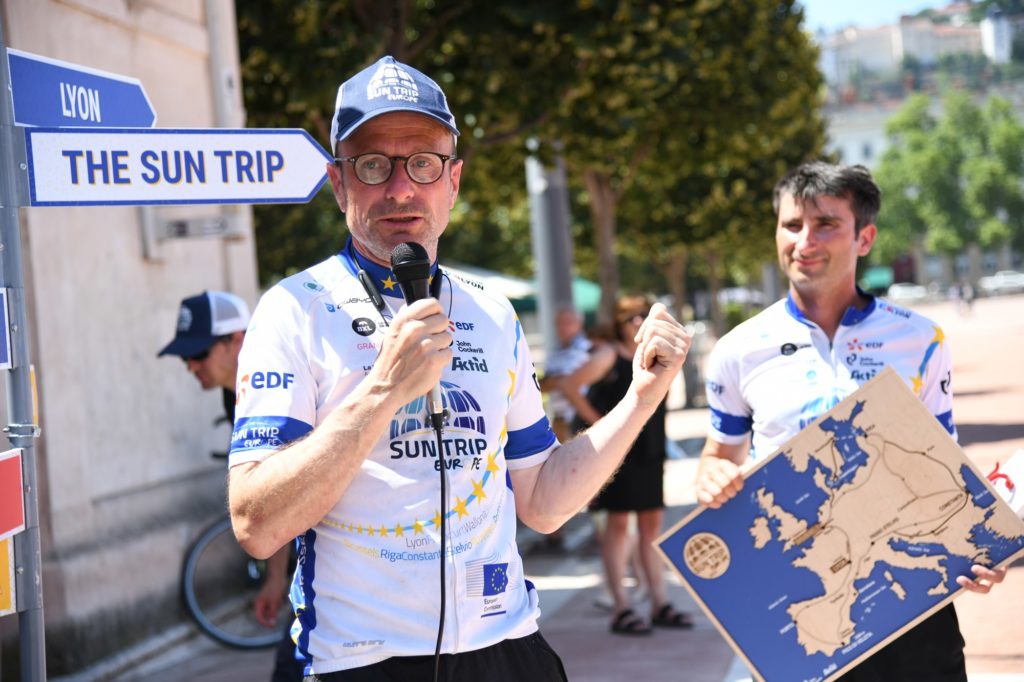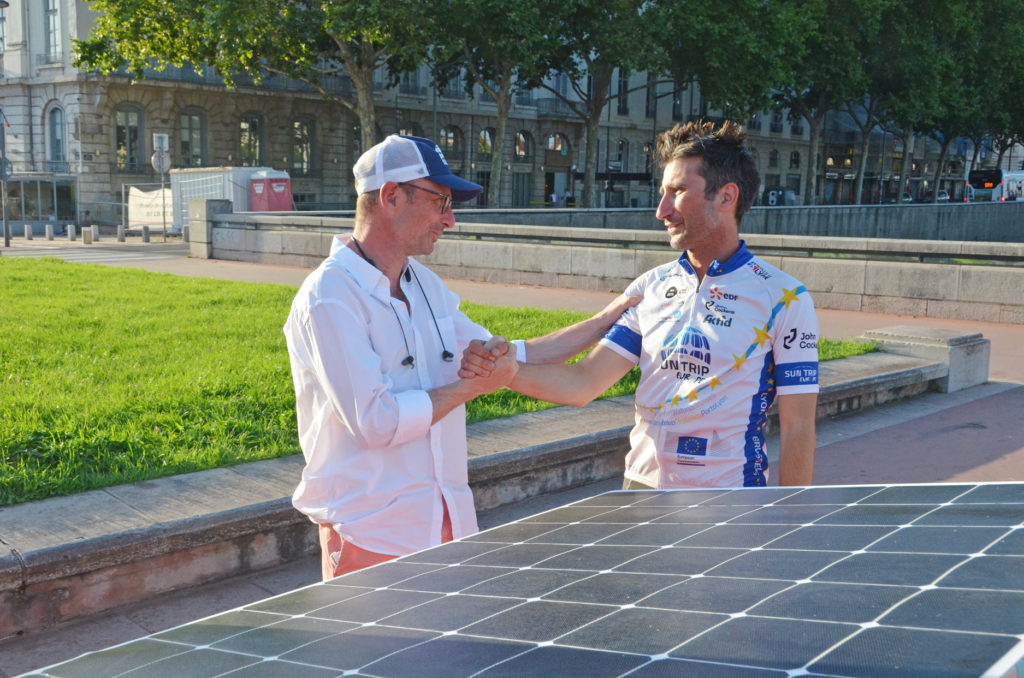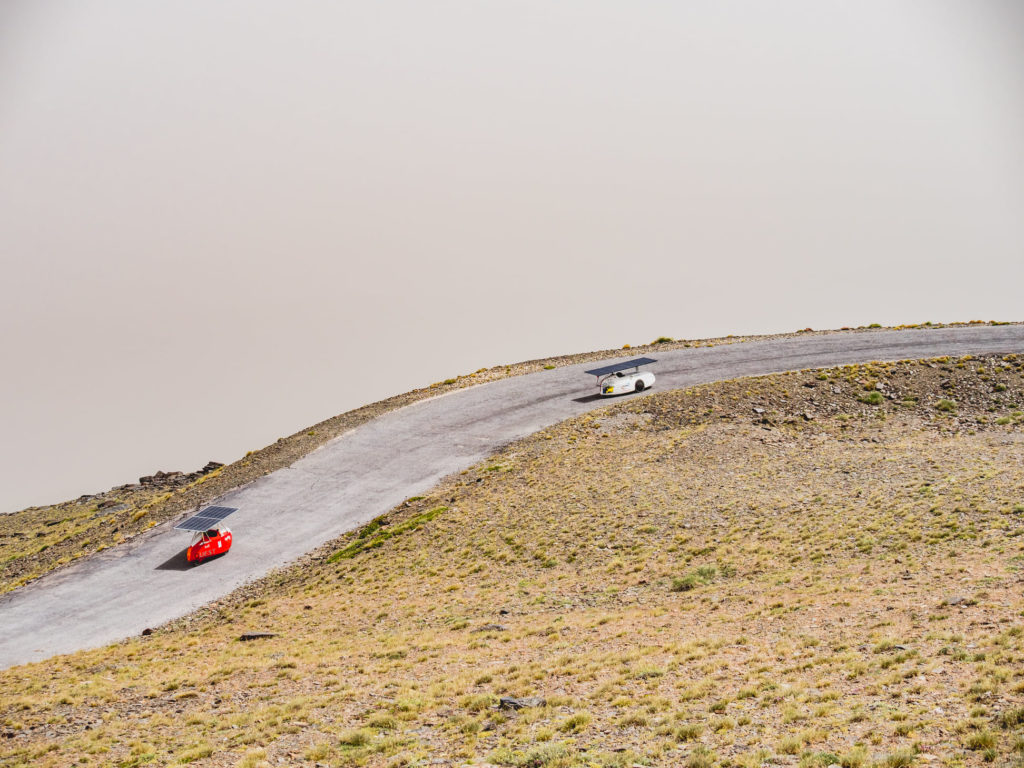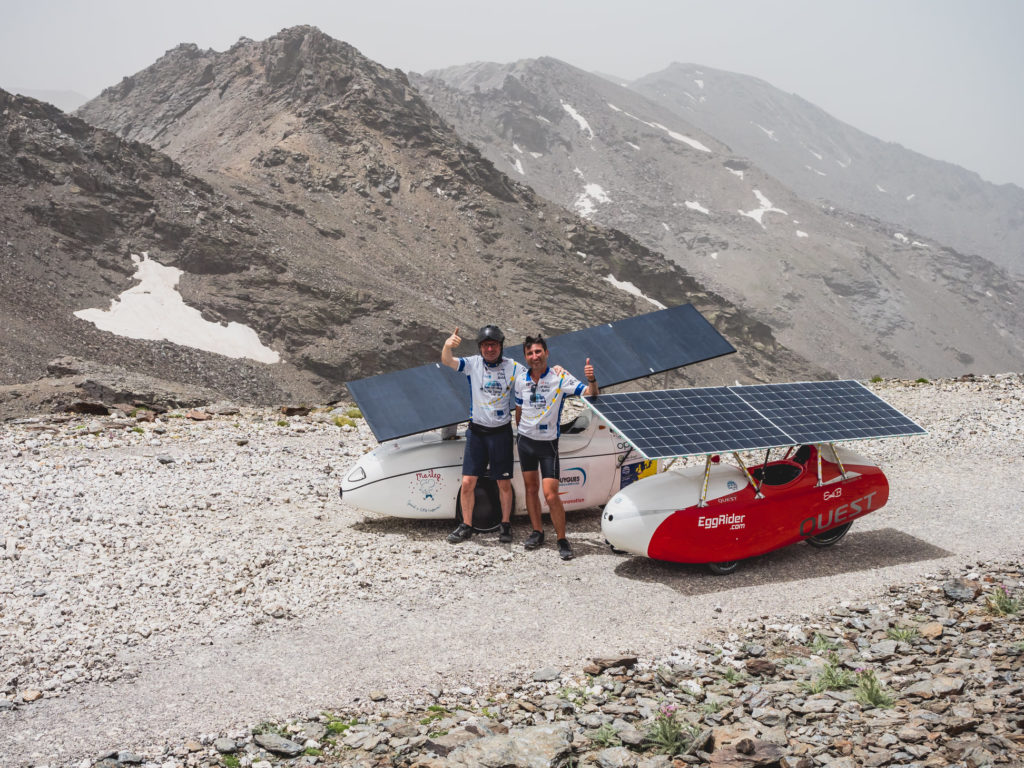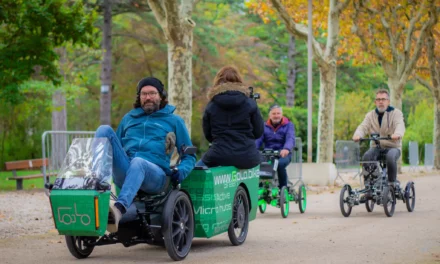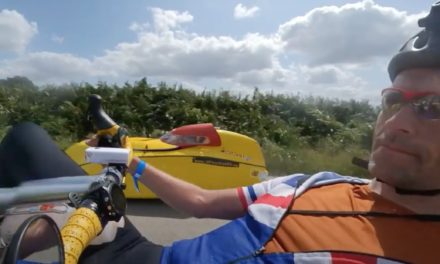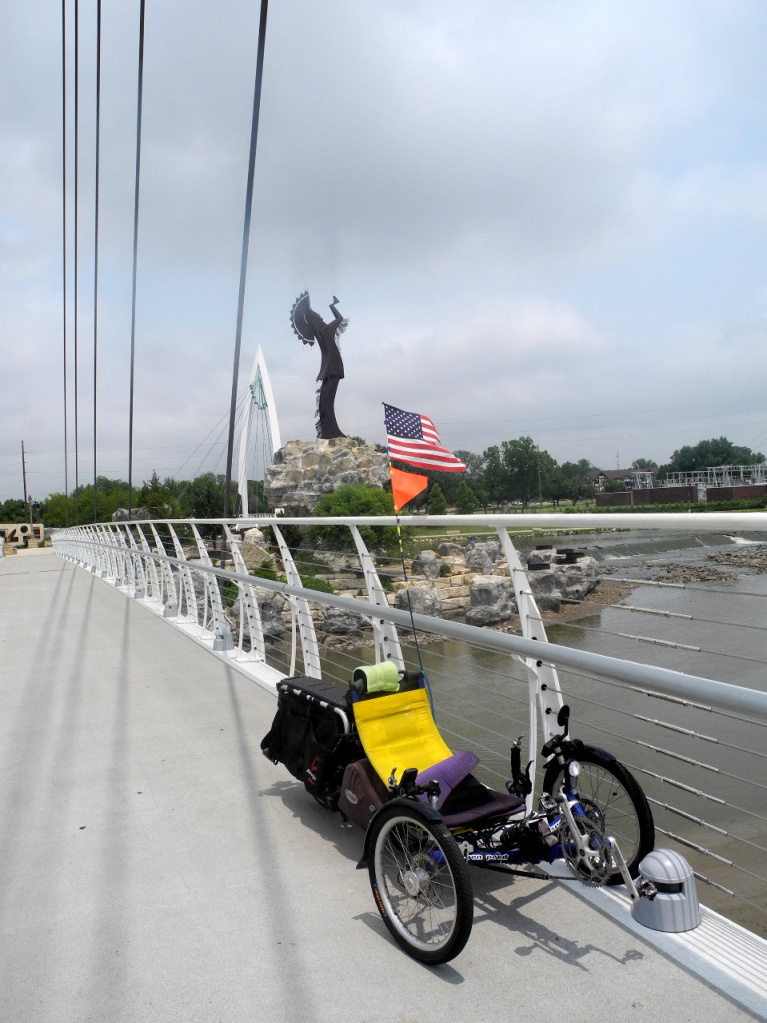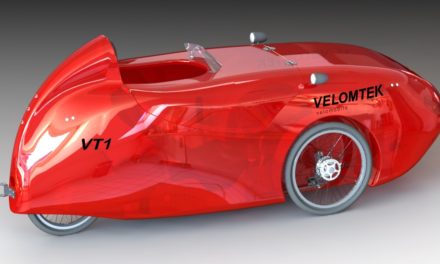Photo: The Sun Trip, Ivan Luque
Following Frenchman Jean-Marc Dubouloz and Romanian living in UK Emil Barbut during their last days of the Sun Trip – the race of solar powered vehicles across Europe – was like watching a Hollywood movie. Just that it took days not hours. But their battle started at the very beginning of the 11.000 km / 6,835 miles long race which led from Brusells, Belgium, through many European countries incl. Germany, Lithuania, Ukraine, Romania, Italy, Spain, but also Belarus and many others. An adventure which combines human-power and most up-to-date technology in the form of a solar-charged battery of an e-bike. Both Jean-Marc and Emil used highly efficient velomobiles with extremely low aerodynamic drag. A mix of properties which can show us, us as a society, a way to a new sustainable transportation.
But there were not only velomobiles, but also recumbent bikes and trikes like the one from Bernard Cauquil who built a tilting delta trike with tilting solar panels and serial-hybrid drive. He finished in third place and shown everybody how efficient and comfortable recumbents are.
Back to the story of Jean-Marc and Emil. After 11.000 km / 6,835 miles of a serious racing they finished in Lyon, France with just 3 hours of difference! Jean-March Dubouloz has won the race in his WAW velomobile. The following double-interview shows how tough the race is. Before and also during the event itself.
Winner: Jean-Marc Dubouloz
11.000 km / 6,835 miles
33 day, 2 hours and 45 minutes
333 km / 207 miles a day in average
354 km / 220 miles a day if we deduct two rest days
Give us some statistical data of your ride first.
Jean-Marc: I will publish all my data at the beginning of September.
Emil: Solar data is still pending the databox analysis, but I can speculate I was getting about 2 kWh a day on average. Average about 350 km / 220 miles a day, more in the first half of the trip, and significantly less in the south of Europe.
When have you decided to participate in The Sun Trip and why?
Jean-Marc: It was not yet six o’clock, a beautiful morning in September 2018, surfing the Internet in my French Normandy, when I came across the video relating the July 2018 edition of the Sun Trip “Lyon (France) – Canton (China)”.
Waw… I mean Wow… it was love at first sight!
Immediately I knew I wanted to participate in this. The images showed strange cyclists progressing on alpine slopes, over the plains of central Europe, or under the overwhelming skies of the Kazakh steppe. Pedaling lying in the shelter under their solar panels, or towing them on a trailer attached to their traditional bicycle, the competitors of the Sun Trip rallied Lyon to … Canton, 12.000 kilometers / 7,500 miles away!
What immediately appealed to me in The Sun Trip is this unprecedented mix of human adventure, sport, technology and it is obviously a new approach to responsible mobility which can only develop in the years to come.
You have to realize that the energy required for each participant to reach Canton is 1/3 of muscular origin and 2/3 of photovoltaic energy. That’s 180 kWh, or about the equivalent of just 18 liters of gasoline to cover 12.000 km / 7,500 miles!
Emil: A few years ago I met a former participant preparing for the trip and I liked the challenge. I am an electrical engineer and I love bicycles, so it was the right thing to do.
Why have you chosen the velomobile? Were you a velonaut even before the decision?
Jean-Marc: Once the decision was made to participate, I, therefore, had to equip myself with a solar bike. As an amateur cyclist for 30 years (around 4.000 km / 2,500 miles per year), I own several bikes, mountain bikes, or road bikes, but none closely or remotely resembles these funny solar machines.
I immediately told myself that I wanted to go on an innovative and efficient bike. I then discovered the velomobile and saw the full potential of this bike, thanks to its unmatched Cx (aerodynamic drag).
Emil: In 2018, out of curiosity I ran some simulations, and the result was that for gradients below about 1% a velomobile was going to be significantly faster. Overall on a mixed route, it was yielding a few days advantage. I have purchased a velomobile in 2019 and I have used it since for commuting, logging about 15.000 km / 9,300 miles. I was definitely convinced by the comfort and reliability. Speed was merely a bonus at that point.
Which part of the route did you like most?
Jean-Marc: Andalousia and its Sierra. I was in the spaghetti western “the good the bad and the ugly” with 40 °C / 104 F of temperature.
Emil: The region that I liked the most was Castile and León (centre-north Spain). Loved the vast distances between cities and quiet roads. Second best was Andalusia (South of Spain), but the excessive elevation and lack of paved roads in some places have ruined the experience.
And what was the most difficult moment?
Jean-Marc: Lots of bad times. It’s so long … But I think the part from Austria to the south of Spain was the hardest for me because I was very tired at the time. I had to stop several times in the morning to take 15 minutes micro-naps. We sleep well in the Waw. Haha
Emil: The most difficult day must have been the Sunday after sleeping at the campsite in France. People were partying until 4 a.m. and I had to wake up at 6 am to ride. To make things even more difficult, all shops were closed so I could not eat properly that day either. The second most difficult must have been Porto. I chose a questionable route with too much climbing, my rear derailleur broke because of overuse, and I was delayed a few good hours to reach the checkpoint. I could not find anything beautiful about the city because of that.
What about climbing the mountain passes, was it difficult?
Jean-Marc: I had participated in the Sun Trip France the previous year which took me through many great passes in the Alps and Pyrenees. much more than during the Sun Trip Europe. So I was well prepared.
Emil: It was easier than I expected. There wasn’t enough sun (neither for Stelvio or Veleta) so I pedaled hard. But seeing so many other cyclists pushing helped.
How did your common day look like?
Jean-Marc: Typical day: Get up at 5:20 a.m. for a 6 a.m. departure. Breakfast while driving, 4 liters of water with me. A 10 minutes break around 10 a.m. to shit in nature (sorry for the detail). A stop around 2 p.m. in a Lidl supermarket (I tested them all in the 18 countries I visited) because it is the right size of the store and I find the same products everywhere in Europe so as not to waste time. 15 minutes max. inside then I eat quickly in the parking and leave. All-day long I eat sandwiches that I prepared the day before with the products bought at the supermarket.
Then, I drive until 8:30 p.m. – 9:00 p.m. the choice of the place to sleep is made with my router around 7:30 p.m., depending on the remaining time of pedaling.
At 9 p.m., a new race against the clock begins, with the aim of going to bed as soon as possible, I have to set up my tent when I bivouacked, then shower, then dinner, then do the mini repairs – maintenance of the Waw, then prepare the next day, prepare the sandwiches, massage the legs which are my working tool. etc.
Every morning, I said to myself “tonight, I go to bed at 10 am and every night, I never managed to go to bed before … 11:30 pm to 12:00 am. Haha
Emil: Started on average at 7:30 a.m. every day, till 20..30. Before 12:00 and after 18.00 I tended to pedal a lot, probably more than half the total power. Between these hours there was too much solar power, so much so that after 13.30 the battery was full and I was wasting power because panels were only working partially. I only stopped to buy food, toilet breaks or to book accommodation.
How often did you follow your competitor? And how much were your decisions based on his behaving?
Jean-Marc: My cell followed my competitor and kept me informed. My router could change my path.
Emil: I tried to leverage any possible mistake that Jean-Marc potentially made, so I preferred to stick to my plans and see the result instead of following him. Often the decisions had to be quick, so checking the map and the competitor behavior would have taken too much precious time.
During the race, I was permanently in telephone contact with Gauthier my router who modified the routes constantly.
Any funny situations on the road?
Jean-Marc: During a stop in the morning on an unpaved road in the Andalusian pampas. I was alone, I had my shorts down and I was crouching to do … I hear a noise just behind me. but very close, about 30 cm / 1 foot. I turn around and see a huge snake (it seemed huge to me, but it was). I broke the world jumping record with my shorts down, screaming in fear. The snake continued on its way as if nothing had happened.
Emil: Nothing particularly funny, because we rode all day. An older lady in the countryside thought I was her son and wouldn’t let me go at some point.
Are there any other topics you would like to mention?
Jean-Marc: This race is crazy because it’s 24 hours a day, every day. Fortunately, my body did not betray me. I arrived in good physical shape but it is mentally that it is very hard: You have to be focused on the road because of the slightest driving error at 40 km/h (25 mph) and that’s the end of the race. You have to manage the cars and trucks that arrive because, to win, you have to take the main roads which are loaded with cars and trucks. You have to manage the cartography, because the changes of roads, the roundabouts, are incessant. You have to manage the data provided by the Cycle Analyst (on-board computer) to better manage the battery charge with what charges in real-time by the solar panels and what discharges it by the power that you put into the motor. You have to deal with the slightest suspicious noise from the machine before it becomes serious. You have to drink and eat all the time. All this, in a very small space where I do not even have the place to take off clothes without having to leave the Waw …
Emil: I do regret not speaking Spanish because I never felt a language barrier so strong before. Spain is a very isolated and vast country, so foreign languages aren’t spoken much.
Premium Members of RECUMBENT.news can read the second part of the interview about the technical aspects of the solar velomobiles, their equipment and challenges related to preparing them and keeping them running during the race.
PREMIUM CONTENT
If you want to read the full article, you have to be a Premium Member.
⭐️ Become a Premium Member for just 10 USD a year! ⭐️
Are you Premium Member? Just Log-in!

